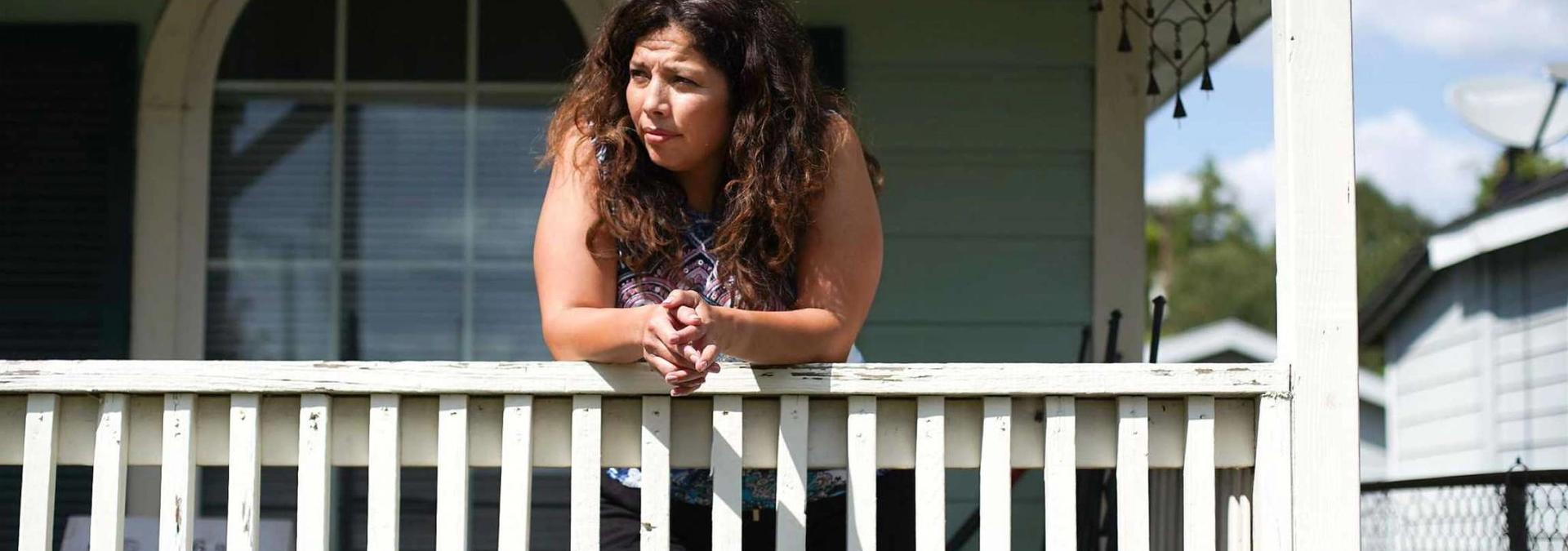
No more 'sacrifice zones.' It's time for Port Houston to become a good neighbor.
Vicki Cruz grew up in Houston's East End. Photo: Elizabeth Conley.
Exasperated, Vicki Cruz prays, “God, where do you want me?”
She loves the East End. It’s where she grew up. But she doesn’t know how much longer she can take it.
She had a long year. Her asthma medication became too expensive, so she’s been going without. An essential worker, she recovered from COVID just in time for the state’s creaky power grid to fail and the winter freeze to burst pipes at the house that’s been in her family for generations.
Every day, she breathed air degraded, in part, by pollution blowing in from the port, developed, maintained and operated by Port Houston. There are many sources of harmful emissions along the Ship Channel, but regulation falls to an uncoordinated armada of agencies, none of which the public-private port is accountable to alone. Everyone’s looking at something, but no one’s watching everything. That lets bad things happen. In 2013, port operations and equipment were responsible for releasing at least four times more of the poisonous, smog-forming nitrogen oxides (NOx) than Exxon Mobil’s Baytown plant.
Cruz lives in the center of it, in a historically Hispanic community that now has the second-highest rate of pollution exposure in the entire eight-county region. It’s the nitrogen oxides, soot and volatile organic compounds from the port, yes, and it’s the 1,3-butadiene from chemical producers, the lead and arsenic aerosols from metal recyclers, the grit from concrete crushers. It all adds up. In Manchester, a few miles from Cruz’s house, cancer rates are 22 percent higher than the rest of the city. During Hurricane Harvey, as petrochemical equipment failed and plants shut down, nearly 94 percent of the extra toxic emissions in all of Harris County were concentrated around here, almost solely in Hispanic, Black and low-wealth communities.
It all seems too much sometimes, Cruz says. “It’s like, ‘Take care of yourself. Get healthy. Sell your dang house and get the hell out of the neighborhood, because all you’re doing is killing yourself.’”
Cruz shouldn’t have to leave, but the port leadership hasn’t done enough to make her feel safe enough to stay. The infrastructure bill moving through Congress presents a real opportunity to change that, though, providing money for ports to retire old, polluting equipment. The port’s nearly $1 billion Project 11 to deepen and widen the Ship Channel for “economic growth,” for example, will use diesel-fueled dredges that will emit about four thousand tons of smog-forming pollutants during years of construction. They say the project will make the port safer and more efficient, eventually, but they haven’t said they’ll spend a single dollar to reduce the emissions while they’re doing the digging.
Meanwhile, every summer, smog, or ground-level ozone, can make the air hurt to breathe, forcing children and anyone with asthma to stay inside to protect themselves. No one is spared. Though people who live closest in the Ship Channel communities — Magnolia Park, Manchester, Channelview, Deer Park, Galena Park, Pasadena, Pleasantville — are harmed the most, for the longest, by this pollution, it blows everywhere, west out to the Energy Corridor and north up to Conroe. Soot, tiny particles that lodge in the lungs and enter the bloodstream, the Harvard School of Public Health and Environmental Defense Fund found, caused Houston in just one year nearly $50 billion in economic damages and more than 5,000 early deaths.
The port seems reluctant to do much about their part of it, hiding behind the excuse of “economic feasibility” to justify their continued dependence on old, dirty equipment, including hundreds of trucks and more than 20 trains first built in the 1950s, while collecting more than $150 million in residential and commercial property taxes the past three years. The Port of Los Angeles says they will retire all their old equipment by 2030. Port Houston hasn’t said they ever will.
If the $1.2 trillion infrastructure bill that has passed through the Senate makes it through the House, the port will need a new excuse for keeping the dirty equipment around. The bill would direct $17 billion in the next five years specifically for ports to transition to zero-emissions, electric equipment and reduce overall pollution.
The bill doesn’t go far enough, says Mustafa Santiago Ali, who championed environmental justice at the Environmental Protection Agency for more than two decades, but “it’s a small step in the right direction.”
He thinks infrastructure should mean more than the repair of roads and bridges and the production of new electric trucks to drive on them. It can lead to equity. Big organizations like Port Houston or the Texas Department of Transportation can take accountability for the history of injustice. They can rebuild the infrastructure of their relationships, which have tended to be “adversarial” and “extractive” of workers’ labor and people’s health, Ali says, especially in those communities that have been denied opportunity and protection through intentionally discriminatory policies like redlining and zoning, or a lack of it. We know all this now, he says. Infrastructure doesn’t have to force a false choice between the economy or the community, growth or death. Illegal air pollution in Texas, Indiana University researchers estimated, chokes at least $240 million every year out of the very same economy Port Houston prides itself on driving. “We shouldn’t put up this scenario of, ‘You either have to choose your life, or a job,’” Ali says. “What is it that communities want?”
Cruz wants to stay home.
Carolyn Stone, who lives to the east of her in Channelview, wants to know what she’s breathing. And she wants to breathe clean air.
She lives near an “island” made of potentially toxic dredge spoils from previous infrastructure projects. She watched the dark plume from the ITC disaster rise from her front door, the firefighting foam with forever chemicals swish down her street. More times than she can remember, she’s waited days for pollution control to come out to determine the cause of a worrying smell, only to tell her there’s nothing they can do. She grew up in Pasadena, and it’s always been like this, she says.
She wants the port to put their money where their mouths are. If they can write blog posts calling themselves “environmental leaders,” they can create a network of air monitors everyone can access. They can establish an alert system. They can invest in clean equipment. They can cut emissions. They can negotiate with the companies using their terminals to electrify their fleets. They can stop using communities as sacrifice zones.
And they can go after the money that will help them do it. The dredging project proves the port is perfectly willing to spend to make the Ship Channel safer and more accommodating for the largest ships. Are they willing to make the air safer for the smallest Houstonians, the children within 2 miles who are 56 percent more likely to develop leukemia?
Infrastructure — our streets and sewers, port terminals and transmission towers, bayou trails and bus shelters — is a manifestation of the many ways we are connected. Sometimes, though, it can work against us, creating and exacerbating inequity. Hurricane Ida’s devastation, after Laura, after Harvey, is more evidence of the need to do right away what it takes to keep our infrastructure from breaking down and breaking us further apart.
With this infrastructure bill, Ali says, and the potential for even more investment through budget reconciliation, “there’s a new set of opportunities.” To begin with, the port should start by junking their dirty trucks and trains — and seeing themselves as part of the communities Stone and Cruz call home.
This article was originally published in the Houston Chronicle.
West is a writer with One Breath Partnership. You can follow him on Twitter @allynwest.
STAY UP TO DATE
The quality of our newsletter is considered satisfactory and poses little or no risk.
SUBSCRIBE

